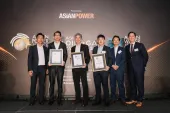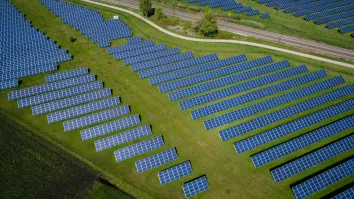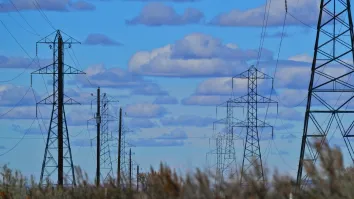
EY Partner about not far off energy future: Empowering customers and rethinking power infrastructures in a transitioning energy mix
The immediate future will be crucial in forging a more sustainable and customer-centric energy framework within the region.
Gregory Poussardin is a Partner at EY Consulting, where he holds over 20 years of experience in providing advisory services to leading power & utility corporations across water, wastewater, electricity, and gas. Currently based in Kuala Lumpur, he focusses on supporting Malaysian and ASEAN utilities on their energy transition journey towards a sustainable net-zero tomorrow.
He has previously led multiple business strategy, operating models, and large-scale business-led, digital-enabled transformations across Europe, Americas, Middle East, Oceania, and Asia.
As part of the esteemed panel of judges for this year’s Asian Power Awards 2024, Gregory shares his thoughts on challenges and opportunities for the Asian power sector, how power utilities are addressing the transition to sustainable and net-zero energy solutions and the role of digital transformation on this undertaking, the evolving balance between traditional energy and renewable energy sources, and what companies can expect on the industry’s future.
What do you consider the biggest challenges and opportunities for the power sector in Asia today?
As we stand at a critical juncture in the power sector in Asia, we are simultaneously confronted with significant challenges and presented with unprecedented opportunities. The energy transition is at the forefront of these challenges as the region is progressively pivoting from a heavy reliance on fossil fuels to embrace renewable energy to align with global climate targets. In powerhouse economies like China and India, coal is expected to remain significant in the energy mix, but the impetus to reduce this dependency is gaining momentum. Notably, Asia accounted for approximately 50% of global growth in renewable energy capacity in recent years, according to the International Renewable Energy Agency (IRENA).
The Asian region is on an accelerated path of energy transition, particularly within ASEAN, where energy demand is projected to grow by 45% by 2050 to support rapid economic development and the need for broader energy access, according to the EY Energy and Resources Transition Acceleration (ERTA) model. As such, the transition is not solely about environmental stewardship; it is equally about economic empowerment and social resilience.
The demand is propelled by increased electrification, with the industrial sector's electricity in need to expand swiftly due to economic growth: 65% of the growth in electricity demand through 2050 is expected to come from the industrial sector alone. In particular, the transport sector is undergoing electrification, further driving the region's electricity demand where local governments are taking multiple initiatives to capture the economic value of e-Mobility. To name a few of these flagship programmes, Hong Kong's government provided subsidies for electric vehicles (EV) purchases and aimed to have all newly registered private cars be electric by 2035, the Ministry of International Trade and Industry of Malaysia launched a National Automotive Policy expected to make the country a regional leader in EV manufacturing and related services, and the Philippines released its Public Utility Vehicle Modernisation Program, which includes the deployment of electric jeepneys and buses.
The dramatic decline in renewable energy costs, particularly solar PV which has seen an over 80% price reduction in the last decade, is making alternatives to fossil fuels increasingly viable. Another telling example is the global weighted average LCOE for solar PV, now 29% lower than the least expensive fossil fuel option globally. In Asia, there are multiple examples highlighting the region's ambitious goals for renewable energy. For instance, China led the world in new solar PV installations, with over 30 GW installed in a single year, underscoring the scale of the transition as highlighted by the International Energy Agency. Its giant neighbor, India, has announced through the Ministry of New and Renewable Energy a plan to expand its renewable energy capacity to 450 GW by 2030. In Southeast Asia, renewable energy capacity is projected to grow by over 8% annually through 2024, demonstrating the region's potential for clean energy expansion. In terms of renewable energy investment attractiveness, China remains in the global top three spot whilst Vietnam and the Philippines continue to rank amongst the top 40 in the latest EY Renewable Energy Country Attractiveness Index due to strong policy support.
Yet, there are several 'handbrakes' to address to maintain the energy transition momentum in the region. Inconsistent regulatory environments across Asia may deter investment, and supply chain combined with infrastructure constraints could impede the expansion of a decarbonised economy.
Regulatory challenges persist, with diverse frameworks across Asian countries leading to some uncertainties, such as the variance in feed-in tariffs and renewable energy certificates affecting cross-border energy trade. Whilst governments in the region are prioritising electrification and scaling up renewables, robust policies and regulations that bolster clean technologies are still in development. There is a clear case for harmonised policies and regional cooperation. The region is taking steps in the right direction to promoting collaboration on regulatory matters in the energy sector with growing initiatives across the ASEAN Center for Energy (ACE) or the SAARC Framework Agreement for Energy Cooperation for example.
Infrastructure investment is another critical area. In Asia, the shortage in renewable energy investments is prominent, despite the region being a significant contributor to greenhouse gas emissions. The structure and design of power markets across Asian countries provide an essential backdrop for investors to fully appreciate the status of renewable energy opportunities and challenges in these markets. Due to the disparate nature of each market, investors must analyse in detail the unique nuances in the barriers of each country. The investment strategies in renewable opportunities to succeed in these markets do invariably vary. Renewable energy investments currently yield returns of approximately 6%, which is still less attractive compared to the double-digit returns of the oil and gas sector. Short-term shareholder demands and the need for more predictable future returns may hinder capital raising efforts and slow down future investments. Achieving net-zero goals in the region could also be jeopardised by stagnated grid investments, which could hinder the integration of decarbonisation technologies such as battery storage, EVs, and other distributed energy resources. The Asian Development Bank estimates that Asia needs to invest around $1.7t per year in infrastructure until 2030 to sustain growth, address poverty, and respond to climate change. This investment is vital for upgrading grids and integrating renewable energy sources. For instance, the Philippines alone aimed to triple its renewable energy capacity by 2030, targeting an increase from 5,439 MW to 15,304 MW, which will require substantial infrastructure development.
Asian power grid infrastructure readiness presents another key challenge. The grids are under immense pressure: strengthening transmission and distribution networks is essential to accommodate renewable energy flows. Enhancing the networks and embedding flexibility capabilities are essential for a balanced and reliable energy system where intermittency issues related to renewable energy tend to increase in the region. The global connection queue for renewable energy has also seen increased wait times, potentially delaying the deployment of these vital energy sources. On the other end of the spectrum, power outages have had a significant economic impact, with damages amounting to €50b in 2021 alone, pointing to the need for network resilience. We can expect similar situations to happen in Asia: as solar installations increase, there is a need to manage their impact on the grid. For instance, during peak solar generation hours, the grid may face limitations due to excess energy. Learning from other geographies, there are three major types of measures that Asian utilities can undertake to prepare for such a situation. First, early investment in grid infrastructure is crucial to accommodate increased DER penetration and to ensure the network system is ready. Second, proper sizing and location planning are essential: being cautious during distributed energy resources plant installation can prevent future curtailment. Third, proper DER integration planning combined with coordination of DER deployment together with grid upgrades and load management strategies are key capabilities to establish. This urgent need for grid modernisation is a real hurdle for Asian countries in delivering their effort to become carbon neutral. Recently, in Vietnam for example, the grid has been unable to cope with the surge in renewable installed capacity preventing renewable generators from selling their electricity to state-run electricity companies, resulting in pointing out major infrastructure flaws and questioning the ability of the country to deliver a successful energy transition.
The supply chain landscape is also undergoing significant changes and is another major challenge to address. The demand for minerals critical for building new energy systems, such as lithium, cobalt, and graphite, is expected to soar, with the US Department of Energy projecting growth rates of 910%, 205%, and 264%, respectively, from 2022 to 2050. This surge in demand is already having profound implications for supply chains in the region.
Finally, customer empowerment is another crucial aspect to ensure a successful energy transition in Asia. This factor, encompassing energy security, affordability and access, management of customer assets, and growing environmental concerns from the community, is so crucial that I will develop it further in this paper.
Despite these challenges, the opportunities for the power sector in Asia, especially in renewable energy generation growth, are substantial. Countries like Indonesia and the Philippines possess vast geothermal resources, and the Gobi Desert offers significant potential for solar energy. Decentralised energy systems, such as Bangladesh's home solar energy programme with over four million systems installed, is revolutionising rural electrification. Indonesia set a target to achieve 23% renewable energy in its energy mix by 2025, further emphasising the region's commitment to sustainable energy.
Energy efficiency markets are also ripe for expansion, as evidenced by Japan's surge in demand for energy-efficient appliances, which has led to a 9% decrease in household energy consumption over the past five years. The rise of electric transportation is also creating new avenues for growth, with China being one of the largest EV markets in the world where electric vehicle sales accounted for about 50% of global EV sales in 2022, according to the China Association of Automobile Manufacturers.
By making anticipatory investments and optimising asset management, Asian power utilities can reduce economic losses from outages and enhance the grid's resilience. Carbon pricing, investment in technology, faster connections of new capacity, embedding intelligence into a digital, bidirectional grid, and strengthening the supply of critical minerals are accelerators that can send the right signals to investors, the industry, and consumers to hasten the shift towards renewables.
Another key opportunity relies in improving electricity interconnections, which are a cornerstone for Asia's energy transition, to create robust networks that integrate renewable energy sources, drive economic growth, and support social development across the region. These interconnections will aim to balance the inherent variability of renewable sources like solar and wind by sharing resources across borders, optimising the regional energy mix, and reducing reliance on fossil fuels. The ASEAN Power Grid, aiming to connect 10 member states to enhance renewable capacity, is a prime example of such an initiative. The World Bank has estimated that South Asia could save up to $17b annually in energy costs with improved interconnections, showcasing the economic benefits of regional cooperation. Improved interconnections also vehicle strategic opportunities to improve on energy access, combating energy poverty, and significantly enhancing the quality of life, especially in remote areas. This aligns with the UN's Sustainable Development Goal 7, which aims to ensure modern energy access for all. Projects like the Greater Mekong Subregion Power Interconnection Project have been instrumental in bringing electricity to rural communities, enhancing education, and living standards. Investing in electricity interconnections is strategic for Asia's sustainable future. It is about more than just energy—it is about catalysing economic and social progress. And it is essential that policymakers, investors, and international organisations recognise this and support interconnection initiatives.
In Southeast Asia especially, the explosive growth in digitalisation, e-commerce, and digital banking across countries like India, Indonesia, Thailand, and Vietnam drives the need for the development of robust data centres with Microsoft and Google amongst the largest investors in the region. This growing demand is a major economic opportunity for power utilities in the region to accelerate their efforts in renewable energy integration with government initiatives aiming to address concerns about sustainable power scalability, meeting the demands of hyperscalers and providers, and growing demand for backup power solutions.
Last but not least, the energy transition is expected to offer significant direct and indirect job opportunities as the shift towards renewable energy sources and the implementation of energy efficiency measures create new ventures across various sectors, especially in the areas of manufacturing, installations, operations, and maintenance. For example, the International Labour Organisation (ILO) forecasts that transitioning to a greener economy could create 24 million new jobs globally by 2030 with a significant proportion in Asia's renewable energy sector. Obviously, structural challenges around age, diversity and skill gaps would need to be addressed to ensure success. But what opportunity does not come with challenges?
How are Asian power utilities addressing the transition to sustainable and net-zero energy solutions, and what role does digital transformation play in this?
In recent years, a chorus of commitments has risen from the power utilities across Asia, with many pledging to reach net-zero emissions by 2050. Amongst these, Tenaga Nasional Berhad (TNB) in Malaysia is actively pursuing a strategy that balances energy growth, customer empowerment and business performance with environmental stewardship. Similarly, CLP Holdings in Hong Kong has laid out a clear roadmap to progressively reduce its carbon footprint, with investments in renewable energy and a gradual move away from coal.
As we reflect on the ongoing journey towards sustainable and net-zero energy solutions in the region, it is a story of gradual progress, collective effort, and evolving innovation. Asian power utilities are navigating this path with a sense of purpose and a vision for a greener future, though the road ahead is long and the milestones are part of a larger, unfolding narrative. Like the continent itself, their approach in pursuing the transition to sustainable and net-zero energy solutions is multifaceted. Nowadays, we see most of the Asian power utilities investing in renewable energy capacity, energy storage projects along with carbon capture innovations, energy efficiency programmes and e-Mobility ecosystem initiatives.
As previously noted, renewable energy investment is a key strategic area for power utilities, with an emphasis on expanding generation capacity where conditions are favourable. This includes countries like China, India, Malaysia, Indonesia, Vietnam, and the Middle East area. The initiatives in these regions are pivotal, laying the groundwork for a shift in energy generation. The choice of renewable sources—predominantly wind, solar, and hydroelectric power—varies according to regional characteristics and resource availability. Power utilities such as China's State Grid or United Arab Emirates’ DEWA for example are enhancing their renewable energy portfolios to harness the potential of solar and wind resources at scale through some of the largest renewable projects in the world.
The increasing prominence of renewable energy sources has elevated energy storage technologies to a critical status. Recognising this, Asian utilities have placed it high on their list of priorities, understanding that effective storage solutions will be pivotal in the transition to a sustainable energy landscape. Battery storage capacity in Asia is projected to grow exponentially as a key enabler to stabilise the grid by addressing the new intermittency challenges. By storing excess energy when production is high and demand is low at several layers of the value chain – Grid-level Battery Energy Storage Systems (BESS), Distribution-level Community Energy Storage Systems (CESS), and residential storage - energy storage technologies ensure a stable and reliable supply of electricity when renewable sources are not generating. The stored energy can then be released back into the grid during peak demand times, helping to balance the grid and maintain a consistent energy supply, facilitating a greater integration of renewables into the energy mix and combating the ‘duck-curve’ effect. In short, energy storage has the potential to smooth supply and demand peaks and help defer the cost of grid expansion and upgrades. According to the latest EY Renewable Energy Country Attractiveness Index (RECAI), BESS deployment is forecast to quadruple to 572GW/1,848GWh by 2030, with Mainland China positioned in the top three BESS markets across the globe. Another great example of such investments in the region is South Korea: ‘Uri nara’ has become one of the world's largest markets for energy storage systems, with policies supporting battery storage. In the meantime, Datan Group, one of the largest state-owner generation companies in China has recently started to operate the world’s largest sodium-ion battery energy storage system connected to a grid.
Another type of storage technology that Asian utilities have started to pilot in a nascent field on their journey towards sustainability is on Carbon capture and storage (CCS) technologies with pioneers like Japan's J-Power together with ENEOS and JX who are venturing for feasibility of domestic CCS storage projects when Tenaga Nasional Berhad and PETRONAS have recently signed a Memorandum of Understanding to explore CCS technology for gas-fired power plants in Malaysia.
Energy efficiency is a growing market where power utilities are expanding due to the region's increasing energy demand, urbanisation, and industrialisation. Governments are implementing policies and regulations to promote energy conservation, such as setting efficiency standards and offering incentives. The primary drivers include the need to reduce greenhouse gas emissions, improve air quality, and enhance energy security. Additionally, the rising cost of energy is pushing both public and private sectors to invest in energy-efficient technologies. Energy service companies (ESCOs) are emerging, offering performance-based contracts that guarantee energy savings. Moreover, international collaborations and financing from development banks are supporting the adoption of energy-efficient practices. The market is also being driven by technological innovation, such as LED lighting, high-efficiency appliances, and energy management systems. Overall, the combination of policy support, economic factors, and technological advancements is shaping the energy efficiency market in Asia. Singapore Power, for example, is methodically implementing programmes to encourage more mindful energy use, whilst also retrofitting buildings with technologies that whisper rather than shout their presence, yet significantly reduce energy consumption. The company is also venturing into energy efficiency financing through collaboration initiatives with financial institutions to provide loans or funds for energy efficiency projects. This financial support makes it easier for businesses and homeowners to invest in energy-saving upgrades.
Asian power utilities are also putting their bet on the rapidly evolving e-Mobility solutions as the electric vehicle movement is gaining momentum, with the infrastructure growing like a network of new pathways across the region. With the cost of Electric Vehicles (EV) decreasing and their range increasing, consumer adoption rates are on the rise, signaling a significant shift in Asia's transportation sector towards electrification. Countries like China, Japan, and South Korea are leading the charge, offering incentives for EV purchase and investing in charging infrastructure. China has emerged as the world's largest EV market, with both state-owned and private enterprises, such as State Grid Corporation of China and BYD, aggressively investing in charging stations and battery technology. Utilities across the region are also partnering with automakers and tech companies to develop smart grids that can support the growing demand for electricity from EVs, ensuring that the integration of these vehicles into the energy system is both efficient and sustainable. Asian utilities are actively exploring new business and revenue models as they look to tap into several value pools in the e-Mobility ecosystem on public or residential charging solutions, technology and data platforms, own-fleet electrification, grid integration and circular battery value chain. CLP in Hong Kong offers a great example of such a new venture with the recent implementation of their advanced e-Mobility market open data platform.
Experts expect much more to come with the rise of a new wave of novel digital low-carbon technologies as our utilities are focussing more and more on clean power and sustainable infrastructure. We start seeing Asian utilities considering investments in future energy solutions to cater a decentralised energy near-future where Virtual Power Plant (VPP), Active Network Monitoring (ANM), Network Support Services (NSS), and Dynamic Operating Envelope (DOE) would be the norm. In preparation for this new era, utilities are significantly increasing their investments in enhancing network flexibility, managing the intermittency of renewable energy sources, strengthening grid interconnections, and expanding electricity trading capabilities. These initiatives are not just incremental changes but are part of a broader strategic overhaul to future-proof energy systems against the evolving demands of the 21st century. This matter alone would require a dedicated paper with emerging initiatives across Asia such as the CASA-1000 project that aim at enabling electricity trade between Kyrgyzstan, Tajikistan, Afghanistan, and Pakistan.
In this context, digital is anticipated to be the catalyst for change, enabling smarter energy management, grid optimisation and energy data to lay down the intricate wiring of a vast and complex energy system. This technology transformation to a new energy system is expected to be gradual and to vary across the regions in Asia.
Smart metres and IoT technologies are considered amongst the key enablers since these technologies can facilitate in near or real-time the monitoring of the network and help improving on demand-side management. Therefore, smart metres are being rolled out extensively across Asia, with China leading the way with over 500 million smart metres installed, and where TNB has been rolling out 50% of its smart metres programme target across Malaysia in just a few years, whilst PLN in Indonesia is running several implementation pilots.
Advanced analytics and artificial intelligence combined with microservices architectures are revolutionising energy demand prediction and renewable energy optimisation. AI is expected to be a fundamental building block for the clean energy transition with opportunities to improve energy management, renewable energy sources integration, automating routing tasks along with providing real-time insights into grid operations, helping utilities monitor performance, detect anomalies, and prevent outages. Asian utilities are steadily using these digital technologies to enhance their operations, improve service delivery and customer experience with each step into the digital age. In Singapore for example, SP Group already uses AI for solar energy forecasting to balance the grid. Distributed ledger technologies are also being tested for peer-to-peer energy trading, exemplified by Thailand's blockchain-based energy trading platform. These platforms are expected to help regional utilities mitigating the market price volatility in a region where the electricity cost structure for Singapore and the Philippines showcase that 69% to 51% of the electricity cost respectively only accounts for generation as the region is heavily dependent on imported fossil fuels (especially gas, coal and oil in some cases).
Digital transformation also extends to customer experience. Utilities are using mobile apps and online platforms to provide customers with detailed insights into their energy consumption, helping them to reduce their carbon footprint. For example, Tenaga Nasional Berhad in Malaysia is pioneering new budget management, proactive outage notifications and energy-eco management features for their customers through MyTNB app. In the near future, we may expect the deployment of novel solutions in the area to further engage with customers on controlling the distributed energy assets they would own at home like solar panel, EV chargers and residential batteries, transforming the homes into local power stations alike advanced geographies such as Australia are experimenting nowadays.
As we move towards a decentralised energy system reliant on new technologies, vulnerabilities to cyber threats increase. Cybersecurity technologies are becoming the imperative for a secure transition. Asian utilities are investing in cybersecurity measures, such as advanced encryption, continuous monitoring, and regular security audits, to protect the grid and customer data.
Beyond the technologies, the power sector in Asia must continue its effort on regional cooperation, progressive policy reforms and green initiatives funding mechanisms. Finally, our utilities must keep adapting their operating model to accommodate hyper-intelligent grids, respond to the rise of prosumers, capture new non-regulated revenue streams and create operational efficiencies to support the evolving energy demands and the rise of the Customer Energy Resources for a more sustainable future.
How do you see the balance between traditional energy sources and renewable energy evolving in Asia over the next decade?
The balance between traditional and renewable energy sources in Asia is evolving rapidly, with a clear trend towards a more sustainable and diversified energy mix. This transition is plural. It is driven by economic growth, technological advancements, environmental concerns, and policy initiatives, all of which are shaping the future of energy in the region. The concept of a plural energy transition is central to understanding the evolving landscape. This concept acknowledges that there is no one-size-fits-all solution to the energy challenges we face. Instead, it recognises the need for a diverse mix of energy sources to meet the varying demands, at different pace and scale, and conditions across different geographies. In summary, there are multiple energy transition models at different speeds.
As we look ahead to the next decade, the balance between traditional energy sources and renewable energy in Asia is expected to undergo a significant shift. Traditional energy sources like coal and oil have been the mainstay of Asia's energy supply for decades. However, with the pressing need for decarbonisation and adherence to international agreements such as the Paris Agreement, we are seeing a decisive move towards cleaner energy sources. Local governments are clearly focussing on electrification and scaling up renewables, though robust policies and regulations to boost clean technologies are still needed. Countries across Asia, including Japan and South Korea, have set ambitious net-zero emissions targets, which will inevitably lead to a reduced reliance on fossil fuels.
This transition is supported by the increasing cost-competitiveness of renewable energy. It is growth predominantly powered by a major solar boom, with the price of crystalline silicon PV modules having reduced by over 80% since 2010. In certain regions, the levelised cost of energy from renewables is already outcompeting new fossil fuel projects. For example, India's solar auctions have reached historically low tariffs, making solar power an increasingly attractive option. China is poised to maintain its leadership in solar and wind energy, with goals to achieve 1,200 GW of combined solar and wind capacity by 2030. Other sun-rich countries like UAE, Saudi Arabia, Indonesia, Malaysia, and Vietnam are also expanding their solar projects rapidly.
Over the next decade, regions with abundant and inexpensive energy sources, particularly solar and wind, will attract new generation assets, and demand will follow suit. In areas where localised energy supply is not feasible, we will see more projects aimed at supplying green electricity through transmission connections or interconnections or transporting decarbonised green molecules via pipelines or ships.
Natural gas is likely to play a crucial role as a transitional fuel, offering a cleaner alternative to coal and oil whilst providing stability to energy systems that are integrating intermittent renewable sources. In the short to medium term, we expect to see an increase in natural gas consumption as part of Asia's energy mix. We also expect hydrogen to be part of the future portfolio.
However, it is important to stand against a major misconception: despite the strong push for renewables, fossil fuels - coal, gas, and oil - are expected to remain heavily used in power generation, transportation, and hard-to-abate sectors according to the EY ERTA model. In Southeast Asia for example, renewables are projected to account for a 46% share of the energy transition by 2050, whilst hydrocarbons will continue to play a significant role. For solar and wind energy, ASEAN countries have set ambitious targets for 2030 and beyond, with over 99% of the region's wind and solar potential still untapped, indicating significant opportunities for growth. Gas-based power generation is expanding, with projects like the Thilawa gas-based power plant in Myanmar. Nuclear power is also on the rise, with countries like the Philippines, Indonesia, Vietnam, Thailand, Malaysia, and Cambodia showing interest in nuclear capacity.
In various parts of Asia, there has been a considerable flow of capital into coal and thermal power generation in recent times. The strategic shift required for the utilities to transition towards renewable energy sources will be an intriguing process to monitor, as they seek to balance the urgency of change with the practicalities of scale of CAPEX investments and pace of implementation.
In regions where the penetration of renewable energy is more advanced, there are noteworthy strategic initiatives that merit attention. For example, the state of South Australia serves as a compelling case study in this regard. The region is on track to meet its energy needs entirely through solar and wind power by 2027, positioning itself as a pioneer in the renewable energy landscape. AGL Energy is at the forefront of this transition, undertaking a proactive approach with its Torrens Island thermal power stations. The company is in the process of reimagining these facilities as low-carbon industrial energy hubs. This transformation is aimed at fostering the development of electricity-intensive industries, navigating the fluctuations inherent in renewable energy sources, and forging new avenues for economic value. The strategic manoeuvres being executed in South Australia will for sure offer valuable insights for utilities across Asia. Observing and learning from these pioneering efforts could provide a blueprint for others to follow.
What are your predictions for the future of the power and utilities sector in Asia over the next five to ten years?
Well, to be honest, the first thing that came to mind after reading your question is Niels Bohr’s take: “Prediction is very difficult, especially if it is about the future.” It is much like asking my crystal ball for the lottery numbers, to which it may reply “Better odds asking a magic 8-ball.” With that said, if my crystal ball is to be trusted, we can anticipate a rapid surge in renewable energy sources across Asia, unless of course, it is just reflecting my optimistic bias for a more sustainable future. On that point, IRENA economists project for Southeast Asia alone in its ASEAN Energy in 2024 Report that the region’s renewable energy capacity could grow by over 60% in the next five years.
Regardless of the reliability of my fortune-telling tools and economists’ predictions, it is evident that the power and utilities sector in Asia is set to undergo transformative change. The forthcoming five to ten years will be pivotal in forging a more robust, efficient, and sustainable energy framework within the region. My personal conviction is that, beyond the rapid adoption of renewable energy and the ongoing journey towards digitalisation, there are three critical areas in which power utilities across Asia should invest as non-negotiable capabilities.
In addressing the future of the power and utilities sector in Asia, the concept of Customer Energy Resources (CERs) emerges as a central element for a sustainable energy transition. Originating from Australia, where the term CER has gained prominence against Distributed Energy Resources (DER) due to the country's significant adoption of solar energy—boasting the highest solar penetration rate per capita in the world, with one out of three homes equipped with solar panels—CERs offer a compelling model for the rest of the world. CERs encompass a broad range of technologies and services that enable customers to participate actively in the energy system. This includes, but is not limited to, distributed generation systems like solar panels, smart metre infrastructure, energy storage devices, electric vehicles, demand response programmes, and energy efficiency solutions. The Australian example demonstrates the potential for CERs to contribute to a decentralised and more sustainable energy landscape, encouraging Asia to consider similar approaches in its energy policies and infrastructure development.
Customer engagement is the cornerstone of the modern utility sector. By putting customers at the heart of the energy transition, utilities can tailor their services to better meet the evolving needs of their clientele. This can be achieved by offering incentives for energy conservation and for the adoption of renewable energy generation at the customer's premises. Such initiatives will empower customers to contribute to a more sustainable energy ecosystem, reducing reliance on traditional, carbon-intensive power generation and enhancing the overall resilience of the energy grid. In that world, customers are expected to become the “heroes of net zero” according to a fascinating thought leadership on CER Choreography recently published by EY Australia.
The imperative for the energy transition in Asia to be customer-centric is clear. By leveraging advanced technologies and fostering customer engagement, utilities can create an interconnected ecosystem that not only supports the integration of CERs but also promotes a sustainable, efficient, and resilient energy future. In essence, the active participation of customers in generating, storing, and managing energy aligns with the broader goals of the energy transition, driving the region towards a low-carbon economy and facilitating the achievement of environmental and sustainability targets.
The second aspect of my prediction, which goes hand in hand with Customer Energy Resources, is the emergence of Distribution System Operators, commonly abbreviated as DSOs. The shift towards becoming DSOs is critical for utilities in Asia because it aligns with the increasing penetration of CERs. Asian utilities will be at the forefront of this shift, and they will have to evolve to become the orchestrators of the Customer Energy Resources. A DSO operates, manages, and sometimes owns the local and regional energy distribution networks that transport electricity to end users. In an increasingly decentralised energy landscape, DSOs are responsible for connecting renewables, as well as enabling flexibility, supporting electrification, and empowering consumers. As DSOs, utilities take on the role of effectively integrating the distributed resources to provide more reliable and sustainable energy solutions.
This transition to DSOs and the orchestration of a growing base of customer assets, along with effective management of the rise of renewables, is essential in Asia. Power companies that prepare with the right capabilities will be pivotal in delivering a successful energy transition that supports sustainable economic growth and meets the region's increasing energy demands. To effectively manage intermittent energy sources, our utilities must accelerate their investment in intelligent metre and network deployment, grid automation, energy storage solutions, demand response programmes, cloud computing, and advanced forecasting tools. These capabilities are crucial for monitoring and controlling the grid more efficiently, which is expected to lead to better energy management and enhanced customer service. In addition to these capabilities, Virtual Power Plants (VPPs) would benefit from a dedicated highlight due to their transformative potential in the energy sector across the word and in Asia. Virtual power plants aim to aggregate the capacity of Customer Energy Resources to enhance power generation and distribution. They can dispatch energy in response to market signals, providing a flexible and responsive energy supply. This not only stabilises the grid, but also allows customers to monetise their energy assets. In the context of VPPs, batteries are a game-changer, storing excess energy—particularly from intermittent renewable sources—and releasing it when demand is high. This ensures a steady energy supply and paves the way for a more resilient and efficient grid. The strategic deployment of VPPs can revolutionise how energy is managed, offering a scalable and innovative solution that supports the transition to a sustainable energy future in Asia. Beyond the operational aspect of the grid, we may see within the next few years the emergence of new market models that would benefit both prosumers and distribution system operators. To name a few, peer-to-peer energy trading platforms would enable direct energy transactions between consumers and producers, when collaborative energy communities may offer off-grid models where resources are shared and collectively managed at a local level.
The third aspect of my prediction relies on the importance of cross border cooperation and regulatory evolution in the region to unleash the true potential of both CERs and DSOs. Regional stakeholders need to expand on their collaboration initiatives. Collaboration is not just a buzzword, but a strategic imperative in the delivery of a successful energy transition. This collaboration must span across diverse yet unified efforts of governments, private sector players, financial institutions, and communities. Together, they are weaving a resilient and sustainable energy narrative for the region. This collaboration can take various forms in public-private partnerships, international insights sharing or joint trial initiatives.
Knowledge sharing for instance has become the lifeblood of innovation, with platforms like the APEC Energy Working Group or the HAPUA Working Groups fostering an environment where best practices and technical expertise flow freely across borders. This collaborative spirit is particularly vital for emerging economies looking to leapfrog into the future of energy. Through these initiatives, joint research and development projects are no longer confined within national laboratories or corporate R&D centres. Instead, they have expanded into cross-border collaborations, pooling resources, and intellectual capital to solve some of the most pressing energy challenges. Resilience planning has become another example of collaborative frontier across Asia, with stakeholders working together to ensure that the region's energy infrastructure can withstand natural disasters and other disruptions. Initiatives like regional grid interconnections and strategic energy reserves are examples of proactive measures being taken to safeguard energy security.
Policy harmonisation is another critical area where stakeholders must keep finding common ground, particularly to align on renewable energy standards, technology requirement alignment, and grid interconnectivity protocols that would pave the way for a more streamlined and investment-friendly energy market. Moving forward, we may also see changes in regulatory models where Performance-Based Regulation (PBR) would focus on outcomes and performance to encourage Asian utilities in driving efficiencies and innovations alike in Europe. Some regions may also consider introducing market-based regulations. Given the vast and complex nature of policy harmonisation, it will not be elaborated upon here, as it warrants a dedicated and detailed development.
As a judge at the Asian Power Awards, what key criteria do you consider when evaluating projects or companies for recognition?
First, I would like to warmly thank Asia Power for the invitation. I am humbly honoured and sincerely grateful for the privilege of joining the distinguished panel of judges at this year's Asian Power Awards after being a judge on the inaugural Asian Water Awards in 2023. Being part of such a respected group of industry experts reflects the collective commitment we share towards advancing the power sector in Asia.
In my opinion, the Asian Power Awards play an important role in the region, as they not only recognise excellence within the utility industry, but also inspire companies and projects to strive for innovation and sustainability. These awards serve as a benchmark for success, encouraging the adoption of best practices that benefit not just the utilities but also the customers they serve and society at large.
When evaluating projects or companies for recognition, there are several key criteria that I consider essential such as leadership and vision, novel innovation thinking, use of cutting-edge and secured technologies, contribution to a greener future, operational excellence, ecosystem cooperation, considerations for safety protocols, long-term and financial viability.
The paramount criterion I will consider when evaluating initiatives for recognition is the value they provide to customers and the community. Initiatives that place the customer at the centre of the energy transition are of utmost importance in the view of a surge in renewable energy and of a rise in energy customer asset base. Commitment to a customer-centric approach would ensure that the transition to a sustainable energy future is inclusive, equitable, and beneficial for all stakeholders involved. Community-centric initiatives from their end aim at positively affecting local communities, whether through job creation, infrastructure development, or access to clean and affordable energy, are considered favourably.
To me, these approaches have the potential to shape the success of the (multiple) energy transitions in Asia, and it is precisely this that I seek to recognise and honour through the 2024 Asian Power Awards.



















 Advertise
Advertise






